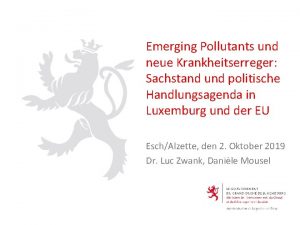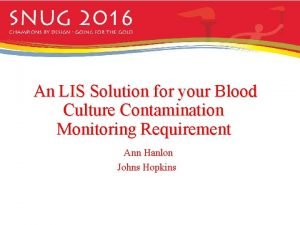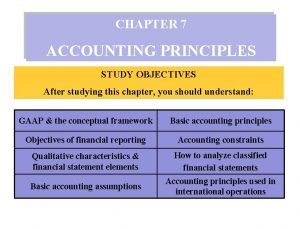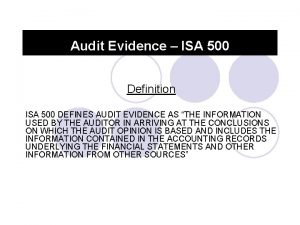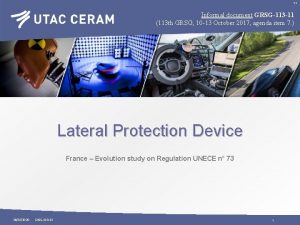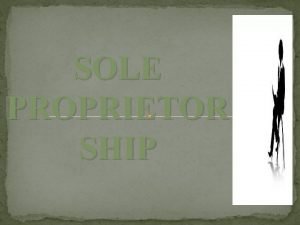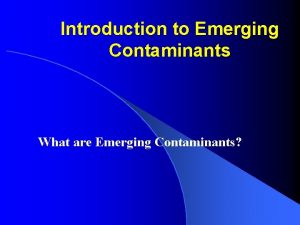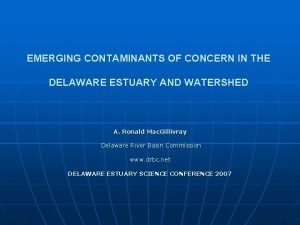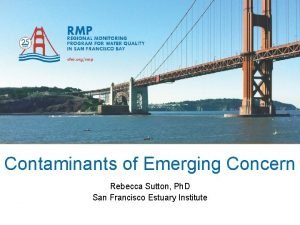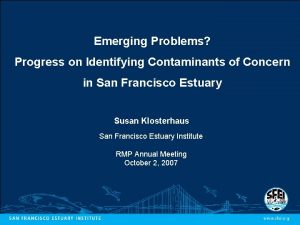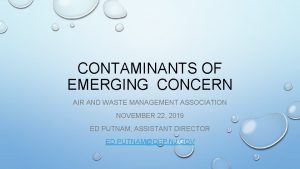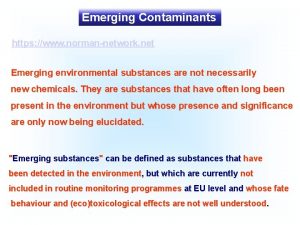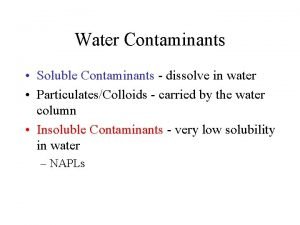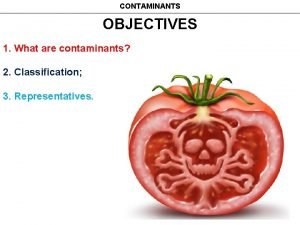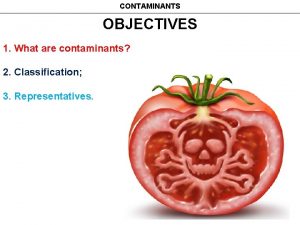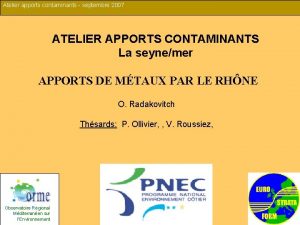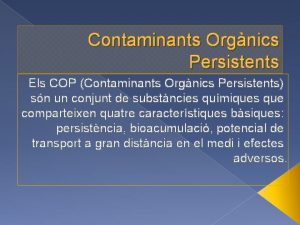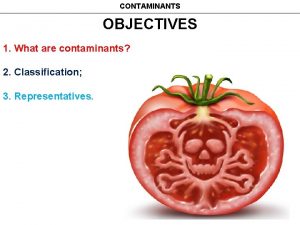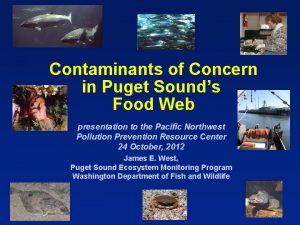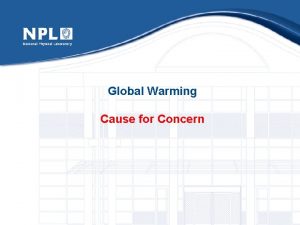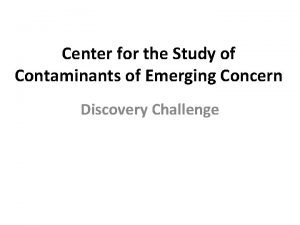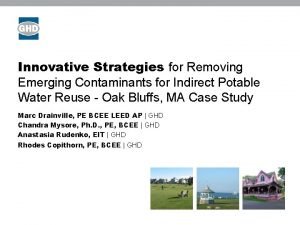Contaminants of Emerging Concern What Are they Why























- Slides: 23

Contaminants of Emerging Concern: • What Are they? • Why Should Solid Waste Facility Managers Care? Billy Newcomb, P. G. Bilgen Yuncu, Ph. D. , P. E. , CAPM Johanna Vaughn

What is a Contaminant of Emerging Concern? • Not necessarily a new chemical • A constituent (chemical, microbe) with potential or real threat to human health • Lack of published health standards • Discovery of a new source or a new pathway to humans

Examples of CECs • Per and Polyfluoroalkyl Substances (PFAS) (e. g. , flame retardants, TEFLON® non-stick coating, Firefighting foam, stain repellant) • Va. SWMR analytes: 1, 1 Dichloroethane, Cobalt, Vanadium

How are CECs Identified? 1. Federal Safe Drinking Water Act 2. Also, • Research and regulatory awareness • Analytical instrumentation advancements • Public Awareness (e. g. , Gen. X, Cape Fear River, NC)

The Safe Drinking Water Act (SDWA) • Established in 1974 • Amended in 1996 • Gives U. S. EPA authority to regulate contaminants in drinking water, and protect drinking water sources

Process for Evaluating a CEC • EPA develops a Contaminant Candidate List (CCL) every 5 years • PWS >10, 000 collect data • Regulatory Decision for at least five contaminants each 5 -year cycle q q Establish a drinking water standard Issue a Health Advisory Defer to next review cycle Drop from CCL

SDWA Evaluation of CECs

Contaminant Candidate List • First CCL 1 announced on March 1998 • …fast forward: ü CCL 4 announced November 2016 ü Carried forward analytes from CCL 3 1. Except regulatory determinations 2. Evaluated new data for CCL 1 and CCL 2

CCL, Cont’d • CCL 4 includes 97 chemicals or chemical groups and 12 microbial contaminants • Includes, ü perfluorinated compounds PFAS ü VSWMR analytes 1, 1 -DCA, Cobalt, Vanadium (and others)

Unregulated Contaminant Monitoring Rule (UCMR) • SDWA requires EPA issue a new list of no more than 30 unregulated contaminants to be monitored by PWS with >10, 000 customers • Logically: the UCMR 4 considers “CCL 4” for potential addition

A CCL may become regulated under SDWA if: 1. It has an adverse effect on human health 2. It occurs in drinking water with a frequency and at levels of public health concern 3. Regulation of the contaminant presents a meaningful opportunity for reducing health risks

Why Should You Care – Isn’t this a Public Water Supply Issue? • If CCL analyte graduates to regulated contaminant, it could significantly impact leachate management, landfill gas management, and groundwater monitoring and corrective action • Good to be aware of this Program • Will likely keep cycling

Example #1 - PFAS • Synthetic compounds formed from carbon chains with fluorine • The C-F bond is the strongest in nature and imparts unique characteristics • PFAS are surfactants that repel oil and water, reduce wear or surface adhesion • Introduced in 1948 (Teflon®) with a great increase in use in the late 1960 s and 1970 s • At low concentrations, many have significant water solubility

PFAS CEC Status • 2009 – CCL-3 and Provisional Health Advisory • 2012 – Added to UCMR – 3 • 2016 – Lifetime Health Advisory (70 ppt) • Found globally in water, soil, air, food, breast milk, umbilical cord blood, and human blood serum • Public concerns are mounting – found in bloodstream of 98% of the U. S. population

PFAS are Not New • 3 M made C 8 before phasing it out in 2000 Ø 2004 Du. Pont/Chemours C 8 spill in West Virginia resulted in a $670 M settlement • Du. Pont made its own version called Gen. X Ø June 2017: Gen. X found in drinking water in the Cape Fear River Basin, NC ü State of NC sued Chemours in 2017 ü Today – finding more and more exposure of Gen. X

PFAS Health Concerns • Persistent, bio-accumulative, and toxic to laboratory animals • Toxicity to humans is being studied ü May function as endocrine disruptors • PFCs can remain in the human body for 4 to 8 years

PFAS Health Concerns • EPA’s National Leadership Summit in Washington, D. C. May 22 -23, 2018 to take action on PFAS • Identify risks from PFAS • Develop monitoring and cleanup techniques • Identify specific near-term actions facing states and local communities • Develop risk communication strategies to help communities address public concerns with PFAS

Remediation Challenges • Not readily degradeable under natural conditions (i. e. , MNA likely not successful) • Difficult to remove by conventional water treatment methods

Remediation Challenges, Cont’d • For more information on groundwater remediation, contact: Ms. Bilgen Yuncu, Ph. D. , P. E. , CAPM Solutions. IES / Draper Aden Associates (919) 873 -1060 byuncu@daa. com

Concerns for Solid Waste Facilities • Widely distributed in consumer goods Ø • Pervasive and Persistent Ø • In the landfill and incinerator waste streams difficult and expensive to remove from the waste stream, leachate, gas and groundwater. Could affect leachate treatment costs, Title V air compliance, landfill gas-to-energy economics and groundwater / surface water management costs

Example #2: VSWMR Analytes • 1, 1 -DCA, Cobalt, Vanadium are on CCL 4 List ü Examples of VSWMR analytes ü These are routinely detected at landfills • Regulated under Subtitle D and VSWMR ü GPS based on ACL or background • If CCL graduates to National Primary Drinking Water Standard – Could affect Compliance Status and Cost

Prognosis • This is not a game of “Gotcha” ü Continuing commitment to protecting public drinking water sources ü Long, thorough process – not knee-jerk ü Likely to continue - not on the chopping block • PFAS – Good chance we will be dealing with these compounds in the future • Current VSWMR - No change anytime soon beyond yearly ACL revisions

Conclusion Keep an eye on the UCMR program: https: //www. epa. gov/dwucmr
 Grundwasserreinigung emerging contaminants
Grundwasserreinigung emerging contaminants Mikael ferm
Mikael ferm Common blood culture contaminants
Common blood culture contaminants Andreas carlsson bye bye bye
Andreas carlsson bye bye bye Water pollution and unequal distribution illustration
Water pollution and unequal distribution illustration Why is water pollution of great concern in southwest asia
Why is water pollution of great concern in southwest asia Dont ask why why why
Dont ask why why why Thematic concern
Thematic concern What do you mean by accounting
What do you mean by accounting Age concern gosport
Age concern gosport 7 accounting principles
7 accounting principles 2010
2010 Going on concern principle
Going on concern principle Going concern assumption
Going concern assumption Trading and non trading organisation
Trading and non trading organisation The term “communicating” as used in accounting connotes
The term “communicating” as used in accounting connotes Growing concern grade 11, 1150l
Growing concern grade 11, 1150l Going concern princip
Going concern princip Teorija i politika bilansa
Teorija i politika bilansa Central city concern housing office
Central city concern housing office Content analysis of secondary data
Content analysis of secondary data The owners of a small manufacturing concern have hired
The owners of a small manufacturing concern have hired Introduction of sole proprietorship
Introduction of sole proprietorship Algorithm efficiency is typically a concern for
Algorithm efficiency is typically a concern for
